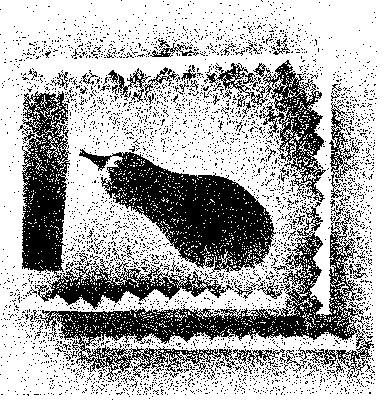 |
| Eggplant drawing by Toki Oshima |
By Roberta Bailey
Eggplant, Solarium melongena var. esculentum, originated in India from a bitter-fruited, spiny plant. Centuries of selection and cultivation have resulted in a fruit with little or no bitterness. Chinese records refer to non-bitter eggplant fruit as early as the 5th century. From there eggplant traveled to Spain, Italy and Africa, where further domestication resulted in the eggplant we know today.
Eggplants range in color from deep purplish black to rose, lavender, white, and purple or pink streaked. Shapes vary greatly, from the long, thin, cylindrical Oriental eggplant to bite-size baby types to large and small oblongs, including the common blocky fruits. Solarium integrifolium, which is cultivated in Asia and Africa, includes red and orange fruit and usually is hollow and small.
Eggplant thrives on heat. From germination to transplant and through the full growing season, the plant needs warmth. If you are starting your own seedlings, plan on sowing them eight to nine weeks before their transplant date. Their seed germinates at 80 to 90 degrees. I pre-sprout the seed by rolling it in a moist paper towel, placing it in a plastic bag and keeping it in the oven, where the pilot light maintains a constant 85 degrees. The seed sprouts in eight to 10 days. Two plants per person will satisfy all but a true eggplant lover.
Plant the seeds in a rich potting soil. I use individual plastic pots, as eggplant is sensitive to drying out and to transplant shock. The seedlings must not get chilled or dried out as such stress often reduces the ability of the plants to fruit. Peat pots can be used if they are kept moist. Seedlings thrive at a constant 70 degrees.
When all danger of spring frost has passed and the temperature is 65 to 70 degrees, gradually harden off the seedlings by increasing their exposure to the outdoors by an hour or two each day, then transplant them to the garden. I water the seedlings in with a seaweed solution or compost tea to help them establish their roots. Protect the young plants from wind and cool nights with floating row covers, cloches or slitted plastic row covers. Eggplant grows well with the added heat of black plastic mulch. Floating row covers also protect plants from flea beetles and Colarado Potato Beetles; both can severely set back tender young seedlings.
When choosing a garden site, give eggplant full sun. Moderately rich, well-drained loam with lots of organic matter and a pH of 6.0-6.8 is ideal. The plants thrive on high nitrogen concentrations but prefer lower levels of potassium and phosphorous. Spacing should be 20 to 24 inches apart in rows 24 inches apart.
As the plants grow, they need an even moisture supply. They do well with a drip irrigation system, but many watering methods work.
When the first blossoms appear, spray the plants with a seaweed extract with one teaspoon of Epsom salts dissolved per gallon. The solution improves fruit set. Depending on the variety, fruit matures 60 to 100 days from transplanting. Eggplants are ripe when they reach the proper color, when the skin is glossy and tight, and, when cut open, seeds are small and barely visible. Young fruits are best; mature eggplants may be bitter.
Eggplant can be grown successfully in a container. Choose compact varieties. A container-grown eggplant can be tucked against a brick wall or sunny patio to yield a crop in chilly climates.
Eggplant succumbs to the same pests and diseases as tomatoes. Flea beetles, aphids, hornworms, and mites can be deterred with row covers. Plant on clean ground to avoid Verticillium and Fusarium wilts. Do not rotate with other nightshade family members, particularly tomatoes, potatoes, tobacco and peppers.
To save seed from eggplant, plant each variety 50 feet apart, or cage plants, or grow just one variety each year. Eggplant flowers are perfect and are primarily self-pollinated. Cages covered in spun polyester row cover must be placed at transplant time to avoid flea beetle infestations. Six plants should be the absolute minimum population base.
Let the fruit go far beyond ripe, actually rotting. The skin will be dull, soft and shrunken. The firm, brown, mature seeds usually occur toward the bottom of the fruit. Grate this over-mature flesh and agitate it in a bucket of water to free the seed. Viable seed will sink, the flesh can be pulled out, the water poured off, and the seed spread to dry in a cool, well ventilated area. Once the seed is dry, store it in a mouse-proof container in a cool, dark area. It will maintain at least 50 percent viability for five or more years. If germination is a problem, try a six-day pre-chill. Simply put the seed in a glass or plastic container in the refrigerator for six days, then germinate it. Your eggplant future is secured.
About the author: Roberta lives in Vassalboro.
